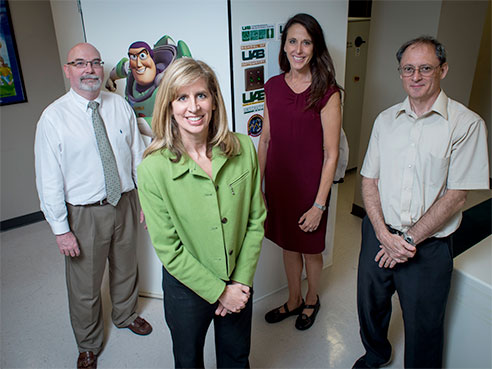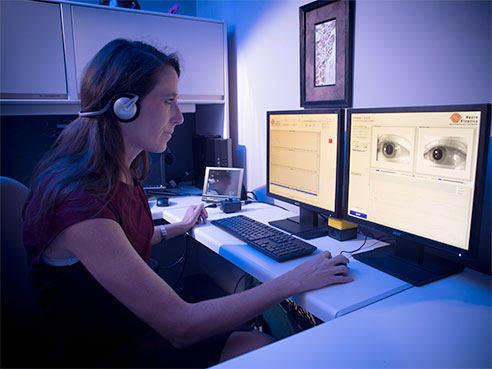 From left: Mark Swanson, Katherine Weise, Jennifer Christy, Claudio Busettini in the VORLab.A new research laboratory at the University of Alabama at Birmingham, the first of this kind in Alabama and one of only a few in America, could lead to a better understanding of the effects of concussions.
From left: Mark Swanson, Katherine Weise, Jennifer Christy, Claudio Busettini in the VORLab.A new research laboratory at the University of Alabama at Birmingham, the first of this kind in Alabama and one of only a few in America, could lead to a better understanding of the effects of concussions.
The Vestibular and Oculomotor Research Laboratory, or VORLab, is conducting research to identify markers of mild traumatic brain injury (mTBI), also known as concussion, in athletes. It is co-directed by Claudio Busettini, Ph.D., associate professor in the Department of Vision Sciences, and Jennifer Christy, Ph.D., P.T., associate professor in the Department of Physical Therapy. Its executive committee includes Katherine Weise, O.D., MBA, FAAO, associate professor in the Department of Optometry, Mark Swanson, O.D., MSPH, professor in the Department of Optometry, and James Johnston, M.D., assistant professor in the Department of Neurosurgery.
Annually, more than 2 million cases of traumatic brain injuries (TBIs) are diagnosed; of those, 75 percent are labeled as mTBI, according to the Centers for Disease Control and Prevention. Symptoms typically include headache, dizziness and balance problems.
“Dizziness in patients with mTBI often is associated with blurred vision during head movements as well as vomiting and nausea. These symptoms likely are related to altered function of the vestibular system and/or subtle abnormalities in eye movements,” Busettini said. “The Vestibulo-Ocular Reflex (VOR) system works to keep vision clear while the head is in motion, such as during reading from your cellphone while walking or, on the field, throwing a football while avoiding an opposing player.”
This interdisciplinary team will use the laboratory to search for mTBI biomarkers in the VOR and oculomotor systems of athletes by determining the negative consequences of mTBI on these systems.
| Annually, more than 2 million cases of traumatic brain injuries (TBIs) are diagnosed; of those, 75 percent are labeled as mTBI, according to the Centers for Disease Control and Prevention. Symptoms typically include headache, dizziness and balance problems. |
“Objective biomarkers are especially important for athletes and young children who might not be able to properly communicate their problems, yet are unable to participate fully in learning and sports. Athletes also might try to hide their problems so that they can continue to play,” Busettini said.
Knowing these mTBI biomarkers will enable investigators to provide a quantitative measure of recovery for a concussed patient. Currently, Busettini says, both diagnosis and monitoring of mTBI recovery are hindered by the absence of reliable biomarkers.
“Standard CT and MRI tests often are negative, suggesting that symptoms may be the result of functional and metabolic neural alterations not well visualized with existing imaging technology. This makes it difficult to determine when there is an actual concussion and when a concussed child can safely ‘return to think’ and ‘return to play,’ as well as to quantitatively evaluate lingering effects,” Busettini said. “Evidence suggests that new injuries on a still-recovering brain exponentially increase the possibility of long-term brain damage, making not only the detection of a concussion a critical factor, but the progress of its recovery, or lack thereof, as well. A comprehensive evaluation of vestibular and oculomotor alterations may therefore be the long-sought-after tool, due to their sensitivity and specificity.”
 The scientists’ search for mTBI biomarkers will be focused on developing, in a highly innovative approach, a comprehensive set of tests that range from pure physiological reflexes to cognitive functions. A group of 180 athletes ages 8-24 will be recruited from the UAB Sports Medicine Concussion Clinic at Children’s of Alabama. In addition, the VORLab is recruiting 60 participants without concussion, ages 19-49, to obtain a normative database. More information on the recruitment can be found on the laboratory Web pages.
The scientists’ search for mTBI biomarkers will be focused on developing, in a highly innovative approach, a comprehensive set of tests that range from pure physiological reflexes to cognitive functions. A group of 180 athletes ages 8-24 will be recruited from the UAB Sports Medicine Concussion Clinic at Children’s of Alabama. In addition, the VORLab is recruiting 60 participants without concussion, ages 19-49, to obtain a normative database. More information on the recruitment can be found on the laboratory Web pages.
“mTBI has a large spectrum of symptoms and issues depending on the brain areas affected by the hit. Our protocols will be tested and optimized on a large number of athletes to search for typical patterns of symptoms and to optimize the sensitivity and speed of the tests,” Busettini said. “Our multifunctional approach, combined with standard functional and cognitive tests, will be the strength of our work.”
The VOR system of the participants in this study will be tested in a new, top-of-the-line system, an advanced high-torque, high-speed rotating chair for vestibular evaluation by Neuro-Kinetics Inc., which includes an integrated setup for visually driven oculomotor testing that will perform tests efficiently, accurately and fast, plus produce high-quality data.
“The high torque of this chair allows tests that cannot be performed with most clinical systems, such as simulating highly controlled and safe hits of the head,” Busettini said. “Only a few major civilian and military centers have comparable systems.”
Other commercially available equipment and prototypes developed on the UAB campus also will round out the battery of tests to be completed in the VORLab to enable a comprehensive assessment of the vestibular, oculomotor, postural control and vision systems.
“The uniqueness of our facility is in the number of different tests that can be performed and, more important, the unique synergy between faculty of different departments and expertise,” Busettini said. “The main aspect of our work will be better outcomes and optimization of the recovery times.”
Funding for this new laboratory came from the UAB Health Services Foundation in the amount of $175,000, with an additional $50,000 from various UAB centers and other UAB sources.
The VORLab is located on the ground floor of the Henry Peters Building, which houses the School of Optometry, easily accessible by patients from optometry, ophthalmology, and Children’s of Alabama, UAB and VA hospitals.
“I am truly enthusiastic that the School of Optometry will host this unique facility, supported by our exceptional UAB faculty, which will put our university as one of the top vestibular and oculomotor centers in the world,” said Kelly K. Nichols, O.D., Ph.D., MPH, FAAO, dean of the UAB School of Optometry.
Although its initial focus will be studying mild traumatic brain injuries in a research setting, the VORLab eventually will be structured as a UAB core facility for intramural or extramural use.
